The Cambridge History of China. Vol. 06. Alien Regimes and Border States, 907-1368
Подождите немного. Документ загружается.

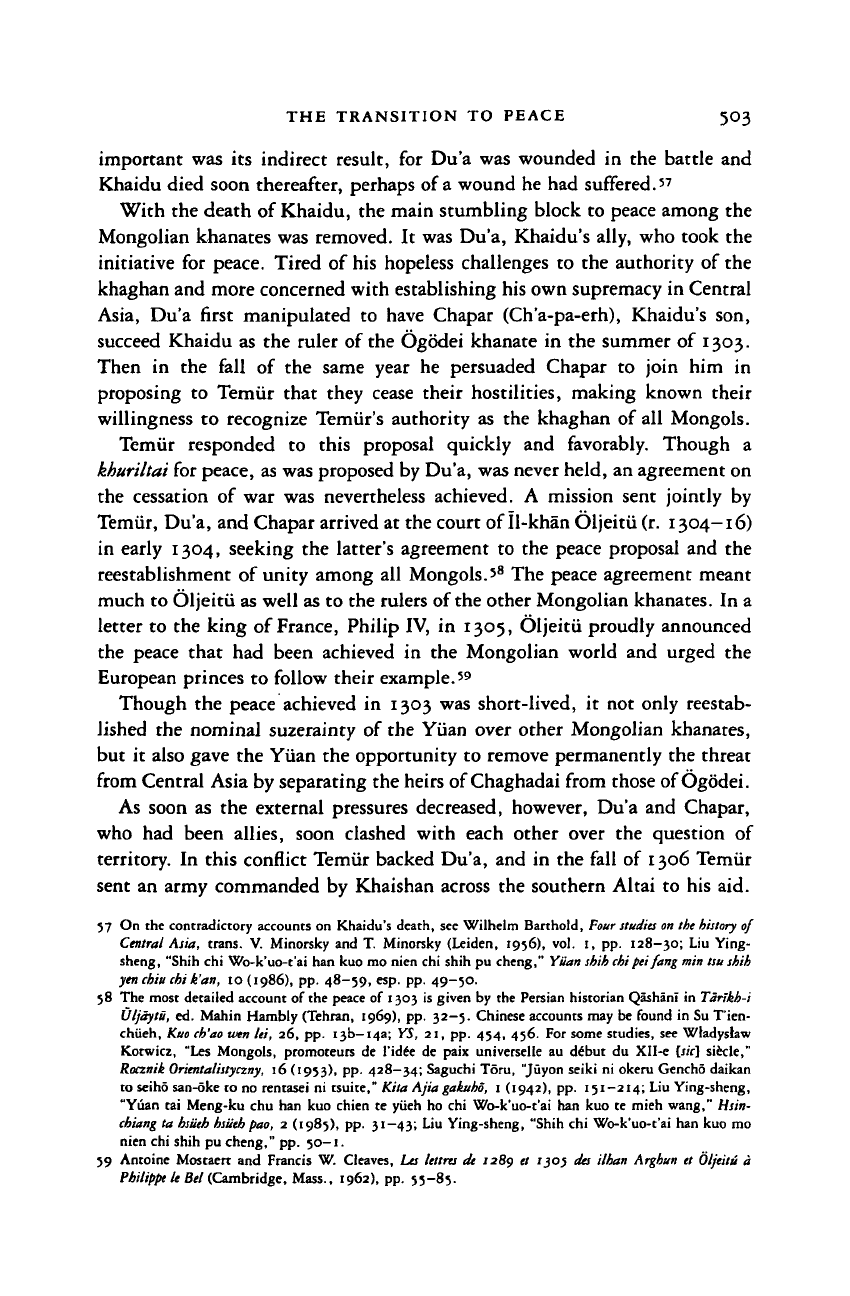
THE TRANSITION TO PEACE 5O3
important was its indirect result, for Du'a was wounded in the battle and
Khaidu died soon thereafter, perhaps of a wound he had suffered.
57
With the death of Khaidu, the main stumbling block to peace among the
Mongolian khanates was removed. It was Du'a, Khaidu's ally, who took the
initiative for peace. Tired of his hopeless challenges to the authority of the
khaghan and more concerned with establishing his own supremacy in Central
Asia, Du'a first manipulated to have Chapar (Ch'a-pa-erh), Khaidu's son,
succeed Khaidu as the ruler of the Ogodei khanate in the summer of 1303.
Then in the fall of the same year he persuaded Chapar to join him in
proposing to Temiir that they cease their hostilities, making known their
willingness to recognize Temiir's authority as the khaghan of all Mongols.
Temiir responded to this proposal quickly and favorably. Though a
khuriltai for peace, as was proposed by Du'a, was never held, an agreement on
the cessation of war was nevertheless achieved. A mission sent jointly by
Temiir, Du'a, and Chapar arrived at the court of Il-khan Oljeitii (r. 1304-16)
in early 1304, seeking the latter's agreement to the peace proposal and the
reestablishment of unity among all Mongols.'
8
The peace agreement meant
much to Oljeitii as well as to the rulers of the other Mongolian khanates. In a
letter to the king of France, Philip IV, in 1305, Oljeitii proudly announced
the peace that had been achieved in the Mongolian world and urged the
European princes to follow their example.'
9
Though the peace achieved in 1303 was short-lived, it not only reestab-
lished the nominal suzerainty of the Yiian over other Mongolian khanates,
but it also gave the Yiian the opportunity to remove permanently the threat
from Central Asia by separating the heirs of Chaghadai from those of Ogodei.
As soon as the external pressures decreased, however, Du'a and Chapar,
who had been allies, soon clashed with each other over the question of
territory. In this conflict Temiir backed Du'a, and in the fall of 1306 Temiir
sent an army commanded by Khaishan across the southern Altai to his aid.
57 On the contradictory accounts on Khaidu's death, see Wilhelm Barthold,
Four studies on
the
history
of
Central Asia, trans. V. Minorsky and T. Minorsky (Leiden, 1956), vol. 1, pp. 128-30; Liu Ying-
sheng, "Shih chi Wo-k'uo-t'ai han kuo mo nien chi shih pu cheng," Yiian shih
chi pei
fang min tsu shih
yen
child
chi fan, to (1986), pp. 48-59, esp. pp. 49-50.
58 The most detailed account of the peace of 1303 is given by the Persian historian Qashani in Tarikh-i
Oljaytu, ed. Mahin Hambly (Tehran, 1969), pp. 32-5. Chinese accounts may be found in Su T'ien-
chiieh, Kuo
ch'ao
wen lei, 26, pp. 13b—14a; YS, 21, pp. 454, 456. For some studies, see Wladyslaw
Kotwicz, "Les Mongols, promoteurs de l'idee de paix universelle au d£but du XH-e [sic] siecle,"
Rocznik Orientalistyczny, 16 (1953), pp. 428—34; Saguchi Toru, "Juyon seiki ni okeru Gencho daikan
to seiho san-oke to no rentasei ni tsuite," Kita Ajia
gakuho,
1 (1942), pp. 151-214; Liu Ying-sheng,
"Yuan tai Meng-ku chu han kuo chien te yiieh ho chi Wo-k'uo-t'ai han kuo te mieh wang," Hsin-
chiang ta
bsiieh hsiieh
pao, 2 (1985), pp. 31-43; Liu Ying-sheng, "Shih chi Wo-k'uo-t'ai han kuo mo
nien chi shih pu cheng," pp. 50—1.
59 Antoine Mostaert and Francis W. Cleaves, Les lettrts de 1289 et 1305 des Man Arghun et Oljeitii a
Philippe le Bel (Cambridge, Mass., 1962), pp. 55-85.
Cambridge Histories Online © Cambridge University Press, 2008
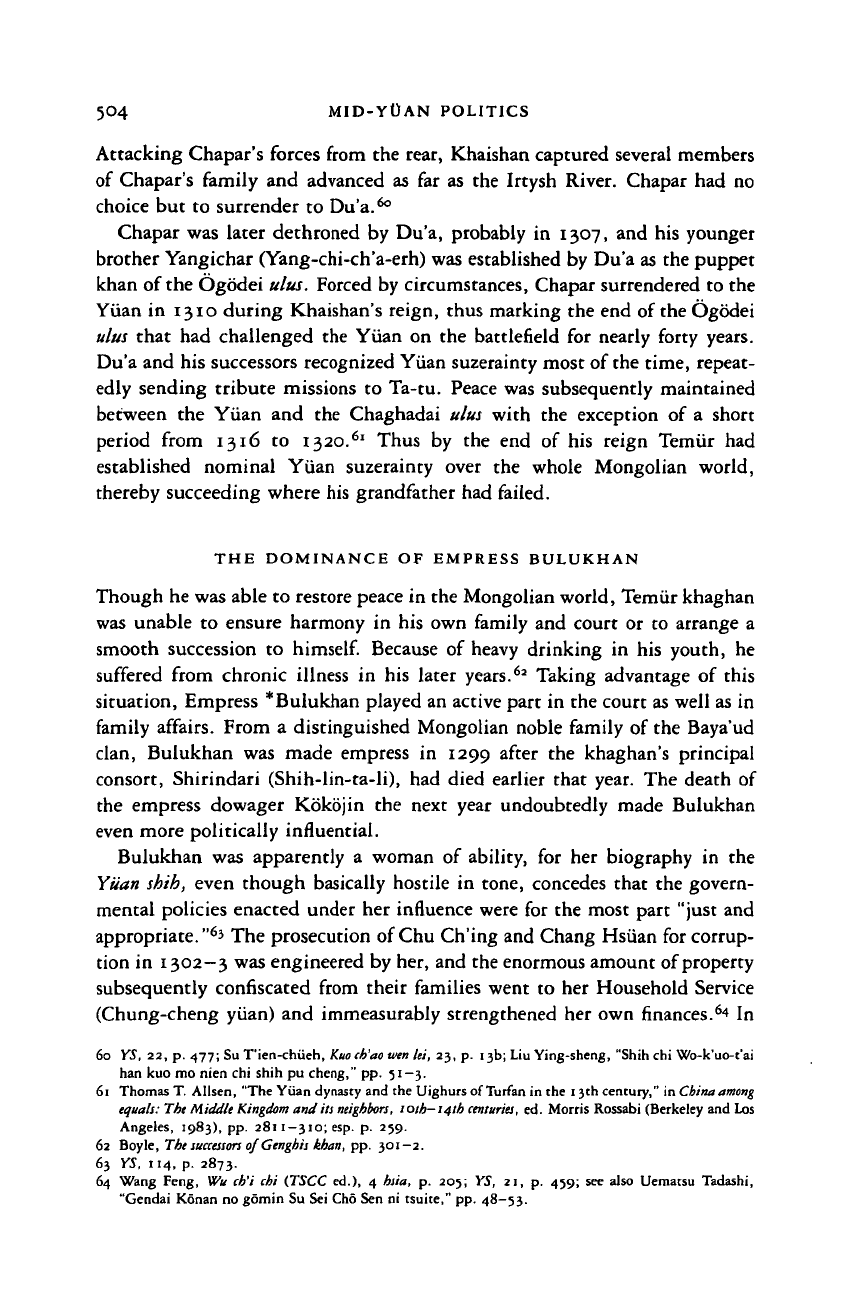
504 MID-YOAN POLITICS
Attacking Chapar's forces from the rear, Khaishan captured several members
of Chapar's family and advanced as far as the Irtysh River. Chapar had no
choice but to surrender to Du'a.
60
Chapar was later dethroned by Du'a, probably in 1307, and his younger
brother Yangichar (Yang-chi-ch'a-erh) was established by Du'a as the puppet
khan of the Ogodei
ulus.
Forced by circumstances, Chapar surrendered to the
Yuan in 1310 during Khaishan's reign, thus marking the end of the Ogodei
ulus that had challenged the Yuan on the battlefield for nearly forty years.
Du'a and his successors recognized Yuan suzerainty most of the time, repeat-
edly sending tribute missions to Ta-tu. Peace was subsequently maintained
between the Yuan and the Chaghadai ulus with the exception of a short
period from 1316
to
1320.
6l
Thus
by
the end
of
his reign Temiir had
established nominal Yuan suzerainty over the whole Mongolian world,
thereby succeeding where his grandfather had failed.
THE DOMINANCE OF EMPRESS BULUKHAN
Though he was able to restore peace in the Mongolian world, Temiir khaghan
was unable to ensure harmony in his own family and court or to arrange a
smooth succession to
himself.
Because of heavy drinking in his youth,
he
suffered from chronic illness
in
his later years.
62
Taking advantage of this
situation, Empress *Bulukhan played an active part in the court as well as in
family affairs. From a distinguished Mongolian noble family of the Baya'ud
clan, Bulukhan was made empress
in
1299 after the khaghan's principal
consort, Shirindari (Shih-lin-ta-li), had died earlier that year. The death of
the empress dowager Kokojin the next year undoubtedly made Bulukhan
even more politically influential.
Bulukhan was apparently
a
woman of ability, for her biography
in
the
Yuan shih, even though basically hostile in tone, concedes that the govern-
mental policies enacted under her influence were for the most part "just and
appropriate."
63
The prosecution of Chu Ch'ing and Chang Hsiian for corrup-
tion in 1302—3 was engineered by her, and the enormous amount of property
subsequently confiscated from their families went to her Household Service
(Chung-cheng yuan) and immeasurably strengthened her own
finances.
64
In
60 YS, 22, p. 477; Su T'ien-chiieh,
Kuo
ctiao wen lei, 23, p. 13b; Liu Ying-sheng, "Shih chi Wo-k'uo-t'ai
han kuo mo nien chi shih pu cheng," pp. 51—3.
61 Thomas T. Allsen, "The Yuan dynasty and the Uighurs of Turfan in the 13th century," in China
among
equals: The Middle Kingdom and its
neighbors,
10th—14th
centuries,
ed. Morris Rossabi (Berkeley and Los
Angeles, 1983), pp. 2811—310; esp.
p.
259.
62 Boyle, The
successors
of
Genghis
khan, pp. 301—2.
63 YS, 114, p. 2873.
64 Wang Feng, Wu ch'i chi (TSCC ed.),
4
hsia,
p.
205;
YS,
21,
p.
459; see also Uematsu Tadashi,
"Gendai Konan no gomin Su Sei Cho Sen ni tsuite," pp. 48-53.
Cambridge Histories Online © Cambridge University Press, 2008
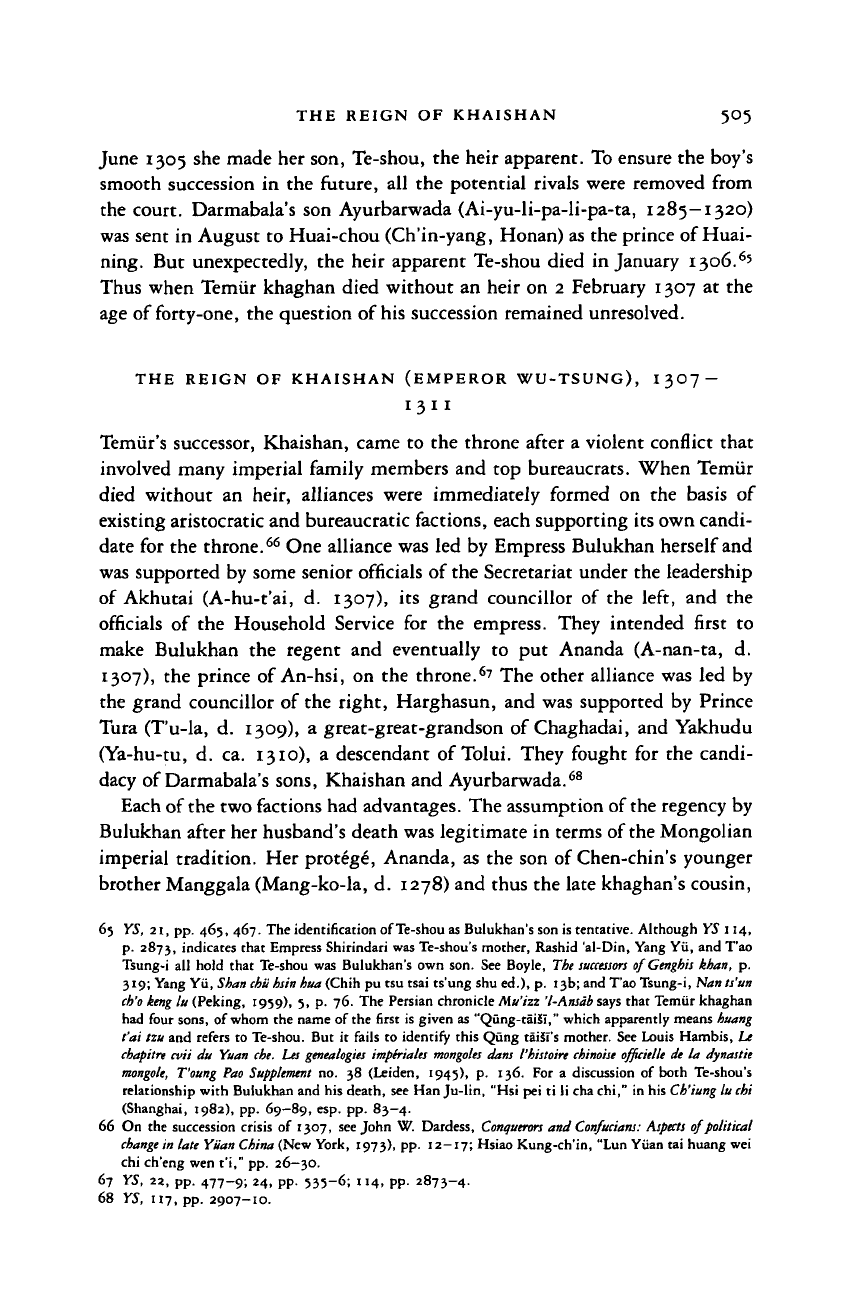
THE REIGN OF KHAISHAN 505
June 1305 she made her son, Te-shou, the heir apparent. To ensure the boy's
smooth succession in the future, all the potential rivals were removed from
the court. Darmabala's son Ayurbarwada (Ai-yu-li-pa-li-pa-ta, 1285—1320)
was sent in August to Huai-chou (Ch'in-yang, Honan) as the prince of Huai-
ning. But unexpectedly, the heir apparent Te-shou died in January 1306.
65
Thus when Temiir khaghan died without an heir on 2 February 1307 at the
age of forty-one, the question of his succession remained unresolved.
THE REIGN OF KHAISHAN (EMPEROR WU-TSUNG), 1307-
I3II
Temiir's successor, Khaishan, came to the throne after a violent conflict that
involved many imperial family members and top bureaucrats. When Temiir
died without an heir, alliances were immediately formed on the basis of
existing aristocratic and bureaucratic factions, each supporting its own candi-
date for the throne.
66
One alliance was led by Empress Bulukhan herself and
was supported by some senior officials of the Secretariat under the leadership
of Akhutai (A-hu-t'ai, d. 1307), its grand councillor of the left, and the
officials of the Household Service for the empress. They intended first to
make Bulukhan the regent and eventually to put Ananda (A-nan-ta, d.
1307),
the prince of An-hsi, on the throne.
67
The other alliance was led by
the grand councillor of the right, Harghasun, and was supported by Prince
Tura (T'u-la, d. 1309), a great-great-grandson of Chaghadai, and Yakhudu
(Ya-hu-tu, d. ca. 1310), a descendant of Tolui. They fought for the candi-
dacy of Darmabala's sons, Khaishan and Ayurbarwada.
68
Each of the two factions had advantages. The assumption of the regency by
Bulukhan after her husband's death was legitimate in terms of the Mongolian
imperial tradition. Her protege, Ananda, as the son of Chen-chin's younger
brother Manggala (Mang-ko-la, d. 1278) and thus the late khaghan's cousin,
65 YS, 2t, pp. 465, 467. The identification ofTe-shou as Bulukhan's son is tentative. Although YS 114,
p.
2873, indicates that Empress Shirindari was Te-shou's mother, Rashid 'al-Din, Yang Yii, and T'ao
Tsung-i all hold that Te-shou was Bulukhan's own son. See Boyle, The
successors
of
Genghis
khan, p.
319;
Yang Yu, Shan
chit
hsin htia (Chih pu tsu tsai ts'ung shu ed.), p. 13b; and Tao Tsung-i, Nan ts'un
ch'o keng
lu (Peking, 1959), 5, p. 76. The Persian chronicle Mu'izz 'l-Ansab says that Temiir khaghan
had four sons, of whom the name of the first is given as "Qung-taill," which apparently means
huang
t'ai tzu and refers to Te-shou. But it fails to identify this Qung taiSTs mother. See Louis Hambis, he
chapitre cvii du Yuan che. Les
genealogies
imperials
mongoles
dans
Vhistoire chinoise offuielle
de la dynastie
mongole,
T'oung
Pao
Supplement
no. 38 (Leiden, 1945), p. 136. For a discussion of both Te-shou's
relationship with Bulukhan and his death, see Han Ju-lin, "Hsi pei ti li cha chi," in his Ch'iung lu
chi
(Shanghai, 1982), pp. 69—89, esp. pp. 83—4.
66 On the succession crisis of 1307, see John W. Dardess,
Conquerors
and
Confucians:
Aspects
of political
change
in late Yuan China (New York, 1973), pp. 12-17; Hsiao Kung-ch'in, "Lun Yuan tai huang wei
chi ch'eng wen t'i," pp. 26—30.
67 YS, 22, pp. 477-9; 24, pp. 535-6; 114, PP- 2873-4.
68 YS, 117, pp. 2907-10.
Cambridge Histories Online © Cambridge University Press, 2008

506 MID-YOAN POLITICS
had strong claims to the throne by way of generational seniority.
69
Ananda's
position, however, was weakened when the issue of lineage was brought into
question. A strong argument was put forward by Khaishan and by Ayurbar-
wada's partisans that "collateral sons were not eligible for the succession," for
Ananda was the only contender for the throne in the post-Khubilai era who
was not a descendant of Chen-chin. Moreover, although Ananda had under
his command the Tangut territory and a large army and had played an
important role in the war against Khaidu and Du'a, he was a newcomer at the
capital and lacked any sizable local army to back up his candidacy. Equally
damaging was the fact that he was a pious Muslim, a clear political disadvan-
tage at a time when the Yuan imperial family had become increasingly
Buddhist. 7°
The other faction was disadvantaged by the fact that neither of its candi-
dates was in the capital at the time of Temiir khaghan's death. Khaishan was
still in western Mongolia and Ayurbarwada in his fief at Huai-chou. Never-
theless, these two brothers had a stronger claim to the throne than Ananda
did, as they were the grandsons of Chen-chin. Moreover, both had sufficient
credentials for their candidacies. Khaishan had been the hero of the war in
Inner Asia and still commanded the most powerful military machine in the
empire. His younger brother Ayurbarwada, on the other hand, had a reputa-
tion as a paragon of Confucian virtue and was popular among the Chinese.
71
But their seizure of the throne could not have succeeded without the support
of Harghasun, who not only controlled the administrative machinery of the
state but who also had taken charge of the imperial guards after Temiir
khaghan fell ill. As the grand councillor of the right, he was able to use
delaying tactics by refusing to countersign the orders issued by Empress
Bulukhan and denying to her faction the use of
all
seals and treasuries, while
at the same time he sent messengers to hasten the arrival at court of Khaishan
and Ayurbarwada.
72
When Ayurwarbada arrived in Ta-tu, he stormed the palace on 4 April
with the troops given to him by Harghasun, in the process killing Akhutai
and arresting Prince Ananda and Empress Bulukhan. With the opposition
thus eliminated, the choice between the two brothers remained a difficult
issue. Although Ayurbarwada enjoyed the advantage of having the capital
under his control, Khaishan was not only senior in age but also enjoyed
military superiority over his younger brother. With their mother, Targi (Ta-
69 On Ananda and his family, see Matsuda Koichi, "Gencho chi no bumposei
—
Anseid no jirei wo
chushin to shite," Shigaku zasshi, 88 (1979), pp. 1249-86.
70 Boyle, The
successors
of Genghis khan, pp. 323—8; see also Wen Yu-ch'eng, "Yuan An-hsi wang yii
tsung chiao," K'ao ku yii wen wu, 4 (1984), pp. 95-7.
71
Dardess, Conquerors
and
Confucians,
pp.
13—15.
72
Liu
Min-chung, Chung
an chi, 15, pp.
12a—b.
Cambridge Histories Online © Cambridge University Press, 2008
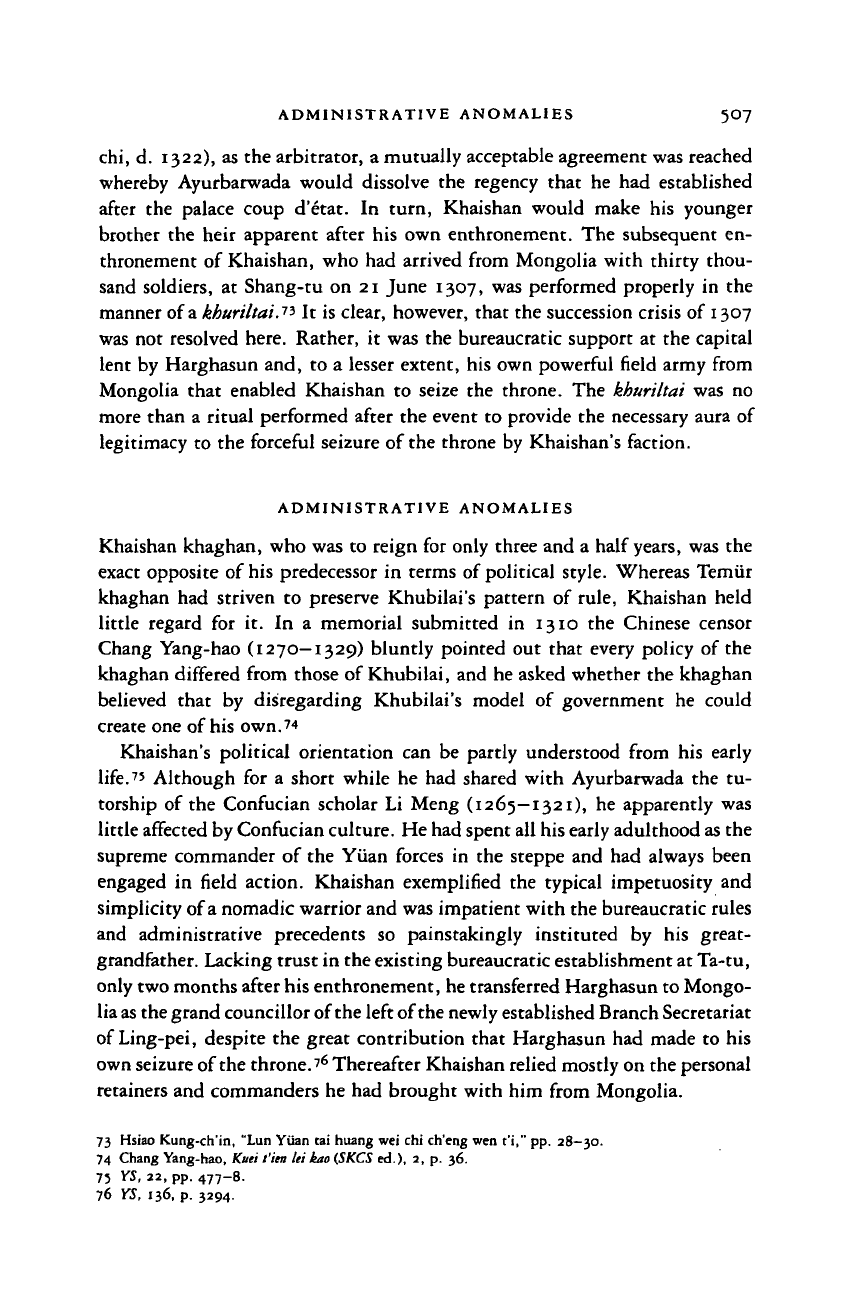
ADMINISTRATIVE ANOMALIES 507
chi,
d. 1322), as the arbitrator, a mutually acceptable agreement was reached
whereby Ayurbarwada would dissolve the regency that he had established
after the palace coup d'etat. In turn, Khaishan would make his younger
brother the heir apparent after his own enthronement. The subsequent en-
thronement of Khaishan, who had arrived from Mongolia with thirty thou-
sand soldiers, at Shang-tu on 21 June 1307, was performed properly in the
manner of
a
khuriltai.
1
^ It is clear, however, that the succession crisis of 1307
was not resolved here. Rather, it was the bureaucratic support at the capital
lent by Harghasun and, to a lesser extent, his own powerful field army from
Mongolia that enabled Khaishan to seize the throne. The khuriltai was no
more than a ritual performed after the event to provide the necessary aura of
legitimacy to the forceful seizure of the throne by Khaishan's faction.
ADMINISTRATIVE ANOMALIES
Khaishan khaghan, who was to reign for only three and a half years, was the
exact opposite of his predecessor in terms of political style. Whereas Temiir
khaghan had striven to preserve Khubilai's pattern of rule, Khaishan held
little regard for it. In a memorial submitted in 1310 the Chinese censor
Chang Yang-hao (1270-1329) bluntly pointed out that every policy of the
khaghan differed from those of Khubilai, and he asked whether the khaghan
believed that by disregarding Khubilai's model of government he could
create one of his
own.
™
Khaishan's political orientation can be partly understood from his early
life.
7
'
Although for a short while he had shared with Ayurbarwada the tu-
torship of the Confucian scholar Li Meng (1265-1321), he apparently was
little affected by Confucian culture. He had spent all his early adulthood as the
supreme commander of the Yuan forces in the steppe and had always been
engaged in field action. Khaishan exemplified the typical impetuosity and
simplicity of a nomadic warrior and was impatient with the bureaucratic rules
and administrative precedents so painstakingly instituted by his great-
grandfather. Lacking trust in the existing bureaucratic establishment at Ta-tu,
only two months after his enthronement, he transferred Harghasun to Mongo-
lia
as
the grand councillor of the left of the newly established Branch Secretariat
of Ling-pei, despite the great contribution that Harghasun had made to his
own seizure of the throne.'
6
Thereafter Khaishan relied mostly on the personal
retainers and commanders he had brought with him from Mongolia.
73 Hsiao Kung-ch'in, "Lun Yuan tai huang wei chi ch'eng wen t'i," pp. 28—30.
74 Chang Yang-hao, Kuei t'ieti lei kao (SKCS ed.), 2, p. 36.
75 YS, 22, pp. 477-8.
76 YS, 136, p. 3294.
Cambridge Histories Online © Cambridge University Press, 2008

508 MID-YOAN POLITICS
Having little regard for the established system, Khaishan freely gave away
inflated noble and official titles and filled the government with supernumerar-
ies who had few or no proper qualifications. Apparently in order to court
support for his authority, he granted nineteen princely titles in 1307 and
1308 alone, fourteen of which were princes of the first rank (i-tz'u
wang).
Of
the fourteen recipients, only two were the sons of the khaghans, thus totally
disregarding Khubilai's unwritten law that only the sons of khaghans could
be made princes of the first rank.
77
Khaishan gave out honorary titles and
ranking bureaucratic appointments even more indiscriminately. As Chang
Yang-hao pointed out, there were even cases of actors, butchers, and Bud-
dhist and Taoist clergymen being given the titles of ministers of
the
Secretar-
iat, and artisans who were given the title of
dukes (kuo-kung)
and councillors
(ch'eng-hsiang).
This statement is by no means an exaggeration, as it can be
corroborated from our sources.
78
In addition to this sort of arbitrariness by the khaghan, another practice
that contributed to the swelling of
the
bureaucracy as well as to the deteriora-
tion of the administration in Khaishan's reign was the issuance by court
attendants
(chin-shih)
of orders dealing with personnel, financial, and legal
matters for their own gain, without going through the proper channels of
government. The "court attendants" in these cases clearly refer to palace
officials and members of the imperial guard,
kesig,
who were close to the
khaghan and the empress dowager Targi.
7
? Within two months of the
khaghan's enthronement, as many as 880 requests for appointments through
palace edicts (net
chiang-chih)
had been made, 300 of which were granted.
Despite repeated protests from the Secretariat, this practice continued, for
such orders were very likely issued with the full knowledge of Empress
Dowager Targi, who often exerted a strong hand in governmental affairs, if
not with the compliance of the khaghan
himself.
80
The rapid expansion of the bureaucracy can be clearly seen at the top
levels.
It was reported in 1307 that there were no fewer than fourteen
ministers in the Secretariat and four censors in
chief.
8
'
One year later the
Bureau of Military Affairs reported in a memorial that the number of the
bureau's chief officials had jumped from six in Khubilai's time to thirty-two
in 1308.
82
In order to save the cost of supporting this tremendously swollen
77 Noguchi Shuichi, "Gendai Mushu cho no ogo juyo ni csuite: gcnshi Shoohyo ni kansuru ichi kosacsu,"
in Ajia shominzoku ni
okeru
shakai
to
bunka:
Okamoto
Keiji
lensei
taikan kinen
ronshu,
ed. Okamoto Keiji
sensei taikan kinen ronshu kankokai (Tokyo, 1984), pp. 271—305; Li Tse-fen, Yuan sblh hsin
chiang
(Taipei, 1978), vol. 3, pp. 349-51.
78 Chang Yang-hao, Kuei t'ien lei
kao,
2, pp. ioa-b; YS, 22, pp. 481, 484, 501; 23, p. 524.
79 On the influence of the kesig, see Ch'i-ch'ing Hsiao, The military
establishment
of the
Yuan
dynasty,
p. 41.
80 YS, 22, pp. 485, 487, 492, 497; 23, pp. 509, 516.
81 YS, 22, p. 481.
82 YS, 22, p. 501.
Cambridge Histories Online © Cambridge University Press, 2008
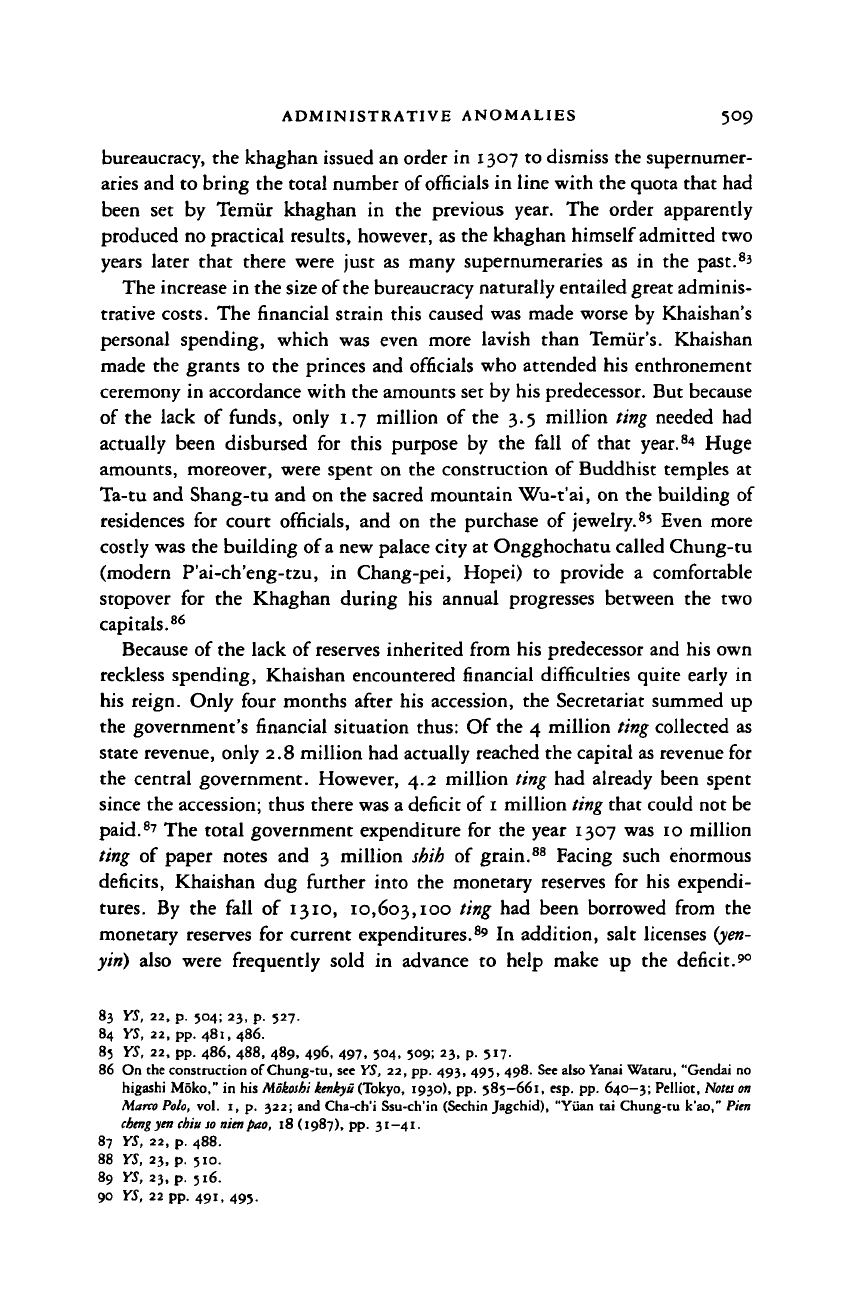
ADMINISTRATIVE ANOMALIES 509
bureaucracy, the khaghan issued an order in 1307 to dismiss the supernumer-
aries and to bring the total number of officials in line with the quota that had
been set by Temiir khaghan in the previous year. The order apparently
produced no practical results, however, as the khaghan himself admitted two
years later that there were just as many supernumeraries as in the past.
83
The increase in the size of the bureaucracy naturally entailed great adminis-
trative costs. The financial strain this caused was made worse by Khaishan's
personal spending, which was even more lavish than Temiir's. Khaishan
made the grants to the princes and officials who attended his enthronement
ceremony in accordance with the amounts set by his predecessor. But because
of the lack of funds, only 1.7 million of the 3.5 million ting needed had
actually been disbursed for this purpose by the fall of that year.
84
Huge
amounts, moreover, were spent on the construction of Buddhist temples at
Ta-tu and Shang-tu and on the sacred mountain Wu-t'ai, on the building of
residences for court officials, and on the purchase of jewelry.
8
' Even more
costly was the building of
a
new palace city at Ongghochatu called Chung-tu
(modern P'ai-ch'eng-tzu, in Chang-pei, Hopei) to provide a comfortable
stopover for the Khaghan during his annual progresses between the two
capitals.
86
Because of the lack of reserves inherited from his predecessor and his own
reckless spending, Khaishan encountered financial difficulties quite early in
his reign. Only four months after his accession, the Secretariat summed up
the government's financial situation thus: Of the 4 million ting collected as
state revenue, only 2.8 million had actually reached the capital as revenue for
the central government. However, 4.2 million ting had already been spent
since the accession; thus there was a deficit of
1
million ting that could not be
paid.
87
The total government expenditure for the year 1307 was 10 million
ting of paper notes and 3 million shih of grain.
88
Facing such enormous
deficits, Khaishan dug further into the monetary reserves for his expendi-
tures.
By the fall of 1310, 10,603,100 ting had been borrowed from the
monetary reserves for current expenditures.
89
In addition, salt licenses (yen-
yin) also were frequently sold in advance to help make up the deficit.
90
83 YS, 22, p. 504; 23, p. 527.
84 YS, 22, pp. 481, 486.
85 YS, 22, pp. 486, 488, 489, 496, 497, 504, 509; 23, p. 517.
86 On the construction of Chung-tu, see YS, 22, pp. 493, 495, 498. See also Yanai Wataru, "Gendai no
higashi Moko," in his
Mokoshi
ientyii (Tokyo, 1930), pp. 585-661, esp. pp. 640-3; Pelliot,
Notes on
Marco
Polo,
vol. I, p. 322; and Cha-ch'i Ssu-ch'in (Sechin Jagchid), "Yuan tai Chung-tu k'ao,"
Pirn
cbengym chiu so
nimpao,
18 (1987), pp.
31-41.
87 YS, 22, p. 488.
88 YS, 23, p. 510.
89 YS, 23, p. 516.
90 YS, 22 pp. 491, 495.
Cambridge Histories Online © Cambridge University Press, 2008
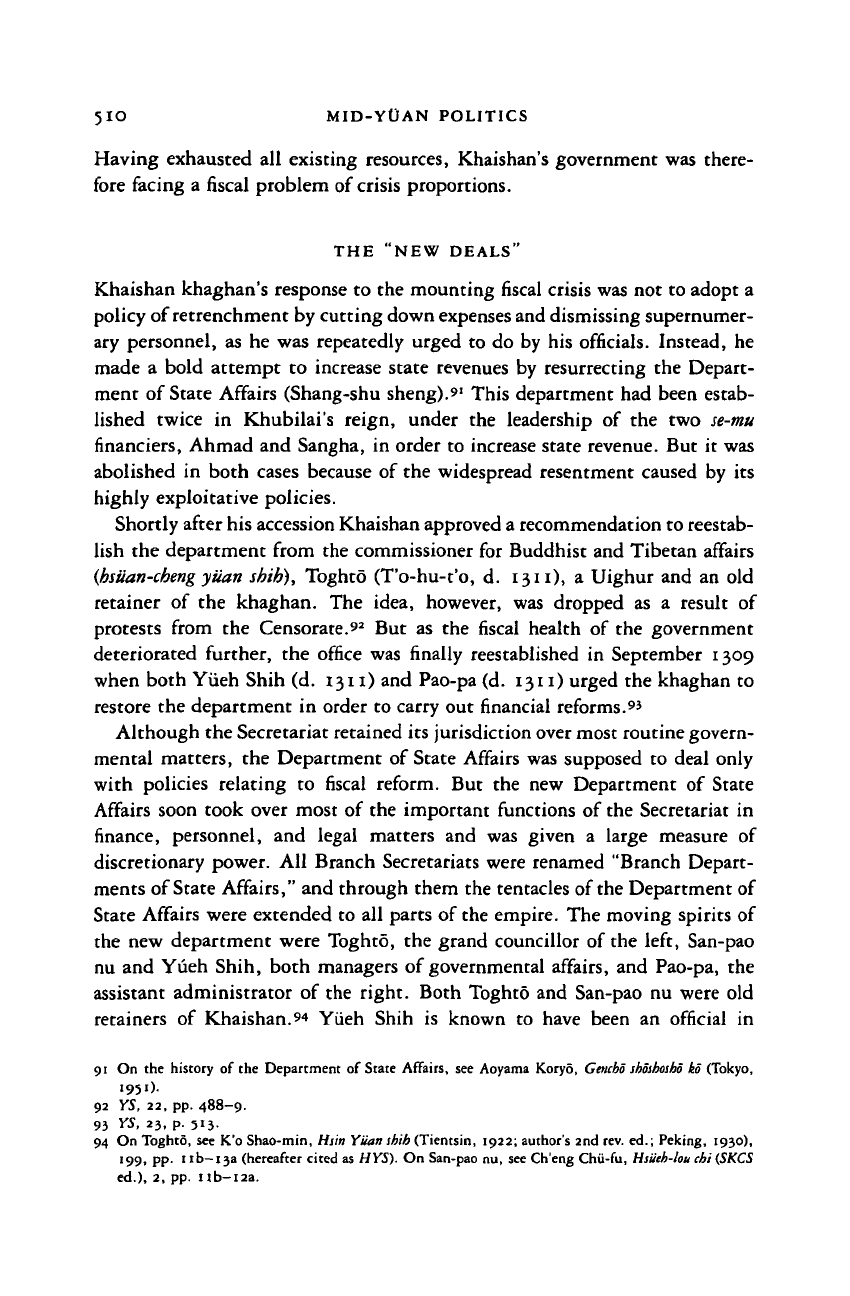
510 MID-YOAN POLITICS
Having exhausted
all
existing resources, Khaishan's government
was
there-
fore facing
a
fiscal
problem
of
crisis proportions.
THE NEW DEALS
Khaishan khaghan's response
to the
mounting fiscal crisis was
not to
adopt
a
policy of retrenchment by cutting down expenses and dismissing supernumer-
ary personnel,
as he was
repeatedly urged
to do by his
officials. Instead,
he
made
a
bold attempt
to
increase state revenues
by
resurrecting
the
Depart-
ment
of
State Affairs (Shang-shu sheng).
91
This department
had
been estab-
lished twice
in
Khubilai's reign, under
the
leadership
of the two
se-mu
financiers, Ahmad
and
Sangha,
in
order
to
increase state revenue.
But it was
abolished
in
both cases because
of the
widespread resentment caused
by its
highly exploitative policies.
Shortly after his accession Khaishan approved a recommendation to reestab-
lish
the
department from
the
commissioner
for
Buddhist
and
Tibetan affairs
(hsiian-cheng
yuan shih), Toghto (T'o-hu-t'o,
d.
1311),
a
Uighur
and an old
retainer
of the
khaghan.
The
idea, however,
was
dropped
as a
result
of
protests from
the
Censorate.
92
But as the
fiscal health
of the
government
deteriorated further,
the
office
was
finally reestablished
in
September
1309
when both Yiieh Shih
(d.
1311)
and
Pao-pa (d. 1311) urged
the
khaghan
to
restore
the
department
in
order
to
carry
out
financial
reforms.
9
'
Although the Secretariat retained
its
jurisdiction over most routine govern-
mental matters,
the
Department
of
State Affairs
was
supposed
to
deal only
with policies relating
to
fiscal reform.
But the new
Department
of
State
Affairs soon took over most
of the
important functions
of
the Secretariat
in
finance, personnel,
and
legal matters
and was
given
a
large measure
of
discretionary power.
All
Branch Secretariats were renamed "Branch Depart-
ments
of
State
Affairs,"
and
through them
the
tentacles
of
the Department of
State Affairs were extended
to all
parts
of
the empire.
The
moving spirits
of
the
new
department were Toghto,
the
grand councillor
of
the left, San-pao
nu
and
Yueh Shih, both managers
of
governmental affairs,
and
Pao-pa,
the
assistant administrator
of the
right. Both Toghto
and
San-pao
nu
were
old
retainers
of
Khaishan.
94
Yiieh Shih
is
known
to
have been
an
official
in
91
On the
history
of the
Department
of
State Affairs,
see
Aoyama Koryo,
Gencho sboihosho
ko
(Tokyo,
92
YS, 22, pp.
488-9.
93
YS, 23,
p. 513.
94
On
Toghto,
see
K'o
Shao-min,
Him
Yuanihib
(Tientsin,
1922;
author's
2nd rev. ed.; Peking,
1930),
199,
pp.
r
ib—13a
(hereafter cited as
HYS).
On
San-pao nu, see Ch'eng
Chii-fu,
Hsmh-lou
chi
(SKCS
ed.),
2,
pp. nb-i2a.
Cambridge Histories Online © Cambridge University Press, 2008
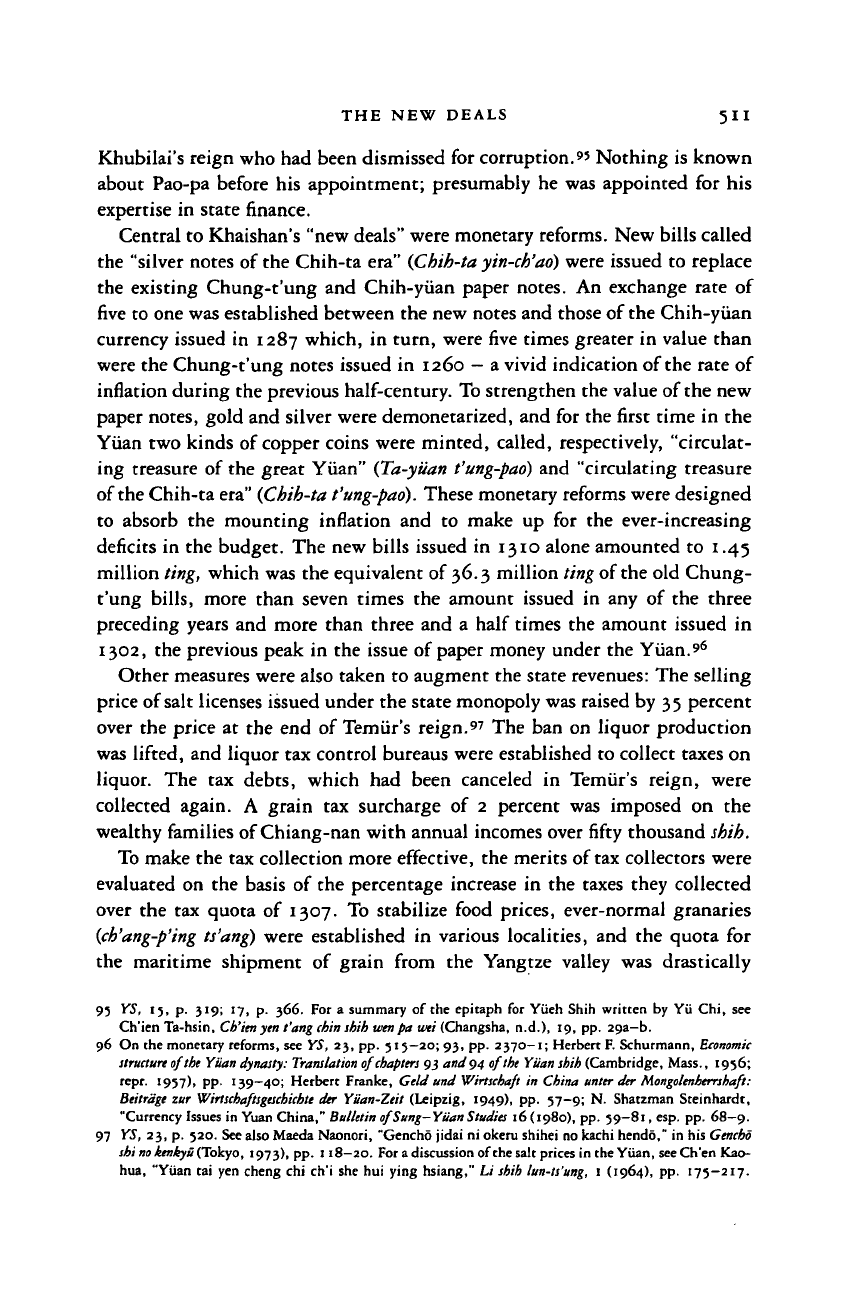
THE NEW
DEALS
5II
Khubilai's reign who had been dismissed for corruption.
9
' Nothing is known
about Pao-pa before his appointment; presumably he was appointed for his
expertise in state finance.
Central to Khaishan's "new deals" were monetary reforms. New bills called
the "silver notes of the Chih-ta era" (Chih-ta
yin-ch'ao)
were issued to replace
the existing Chung-t'ung and Chih-yuan paper notes. An exchange rate of
five to one was established between the new notes and those of the Chih-yuan
currency issued in 1287 which, in turn, were five times greater in value than
were the Chung-t'ung notes issued in 1260
—
a vivid indication of the rate of
inflation during the previous half-century. To strengthen the value of the new
paper notes, gold and silver were demonetarized, and for the first time in the
Yuan two kinds of copper coins were minted, called, respectively, "circulat-
ing treasure of the great Yuan" (Ta-yiian
t'ung-pao)
and "circulating treasure
of the Chih-ta era" {Chih-ta
t'ung-pao).
These monetary reforms were designed
to absorb the mounting inflation and to make up for the ever-increasing
deficits in the budget. The new bills issued in 1310 alone amounted to 1.45
million ting, which was the equivalent of 36.3 million ting of the old Chung-
t'ung bills, more than seven times the amount issued in any of the three
preceding years and more than three and a half times the amount issued in
1302,
the previous peak in the issue of paper money under the Yiian.
96
Other measures were also taken to augment the state revenues: The selling
price of salt licenses issued under the state monopoly was raised by 35 percent
over the price at the end of Temiir's reign.^ The ban on liquor production
was lifted, and liquor tax control bureaus were established to collect taxes on
liquor. The tax debts, which had been canceled in Temiir's reign, were
collected again. A grain tax surcharge of 2 percent was imposed on the
wealthy families of Chiang-nan with annual incomes over fifty thousand shih.
To make the tax collection more effective, the merits of tax collectors were
evaluated on the basis of the percentage increase in the taxes they collected
over the tax quota of 1307. To stabilize food prices, ever-normal granaries
(ch'ang-p'ing
ts'ang) were established in various localities, and the quota for
the maritime shipment of grain from the Yangtze valley was drastically
95 YS, 15, p. 319; 17, p. 366. For a summary of the epitaph for Yiieh Shih written by Yii Chi, see
Ch'ien Ta-hsin,
Cb'ien
yen fang
chin
shih
wen
pa wet (Changsha, n.d.), 19, pp. 29a-b.
96 On the monetary reforms, see YS, 23, pp. 515—20; 93, pp. 2370-1; Herbert F. Schurmann,
Economic
structure
of the Yiian dynasty: Translation of
chapters
93 and 94 of the Yiian shih (Cambridge, Mass., 1956;
repr. 1957), pp. 139—40; Herbert Franke, Geld und Wirtscbaft in China unter der
Mongolenherrshaft:
Beitrdge zur
Wirlschaftsgeschichte
der Yiian-Zeit (Leipzig, 1949), pp. 57-9; N. Shatzman Steinhardt,
"Currency Issues in Yuan China," Bulletin of
Sung—Yiian Studies
16(1980), pp.
59—81,
esp. pp. 68—9.
97 YS, 23, p. 320. See also Maeda Naonori, "Gencho jidai ni okeru shihei no kachi hendo." in his
Gencho
shi
no kenkyu
(Tokyo, 1973), pp. 118—20. For a discussion of the salt prices in the Yiian, see Ch'en Kao-
hua, "Yiian tai yen cheng chi ch'i she hui ying hsiang," Li shih lun-ts'ung, 1 (1964), pp. 175-217.
Cambridge Histories Online © Cambridge University Press, 2008
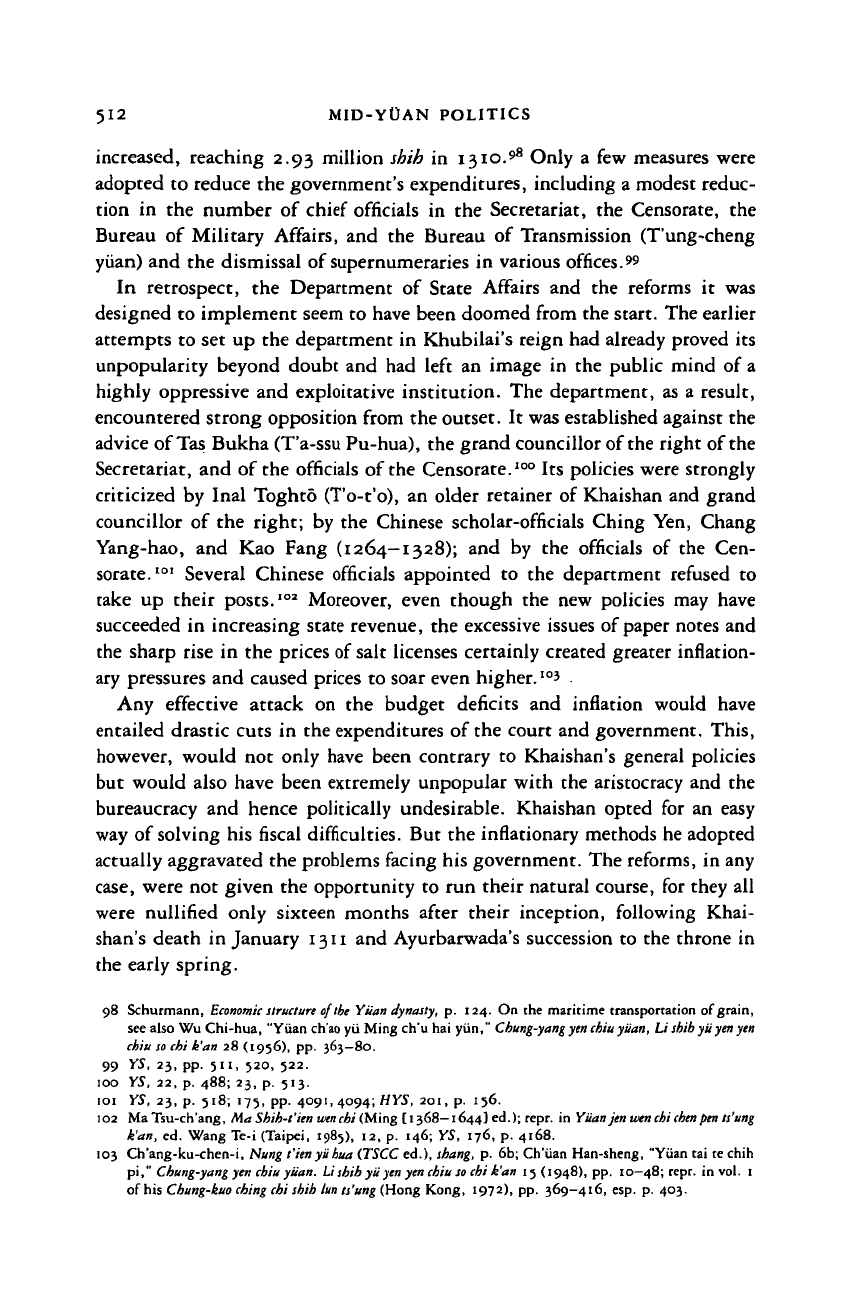
512 MID-YOAN POLITICS
increased, reaching 2.93 million shih in 1310.
98
Only a few measures were
adopted to reduce the government's expenditures, including a modest reduc-
tion in the number of chief officials in the Secretariat, the Censorate, the
Bureau of Military Affairs, and the Bureau of Transmission (T'ung-cheng
yuan) and the dismissal of supernumeraries in various offices."
In retrospect, the Department of State Affairs and the reforms it was
designed to implement seem to have been doomed from the start. The earlier
attempts to set up the department in Khubilai's reign had already proved its
unpopularity beyond doubt and had left an image in the public mind of a
highly oppressive and exploitative institution. The department, as a result,
encountered strong opposition from the outset. It was established against the
advice of
Tas
Bukha (T'a-ssu Pu-hua), the grand councillor of
the
right of the
Secretariat, and of the officials of the Censorate.
100
Its policies were strongly
criticized by Inal Toghto (T'o-t'o), an older retainer of Khaishan and grand
councillor of the right; by the Chinese scholar-officials Ching Yen, Chang
Yang-hao, and Kao Fang (1264-1328); and by the officials of the Cen-
sorate.'
01
Several Chinese officials appointed to the department refused to
take up their posts.
102
Moreover, even though the new policies may have
succeeded in increasing state revenue, the excessive issues of paper notes and
the sharp rise in the prices of salt licenses certainly created greater inflation-
ary pressures and caused prices to soar even higher.
IO
'
Any effective attack on the budget deficits and inflation would have
entailed drastic cuts in the expenditures of the court and government. This,
however, would not only have been contrary to Khaishan's general policies
but would also have been extremely unpopular with the aristocracy and the
bureaucracy and hence politically undesirable. Khaishan opted for an easy
way of solving his fiscal difficulties. But the inflationary methods he adopted
actually aggravated the problems facing his government. The reforms, in any
case,
were not given the opportunity to run their natural course, for they all
were nullified only sixteen months after their inception, following Khai-
shan's death in January 1311 and Ayurbarwada's succession to the throne in
the early spring.
98 Schurmann,
Economic
structure of the Yuan dynasty, p. 124. On the maritime transportation of grain,
see also Wu Chi-hua, "Yuan ch'aoyii Ming ch'u hai yiin," Cbung-yang
yen chiu
yuan, Li
shih
yii
yen yen
chiu
so
chi k'an 28 (1956), pp. 363—80.
99 YS, 23, pp. 511, 520, 522.
100 YS, 22, p. 488; 23, p. 513.
101 YS, 23, p. 518; 175, pp. 4091, 4094; HYS, 201, p. 156.
102 MaTsu-ch'ang, Ma Shih-t'ien
win chi
(Ming [1368—1644} ed.); repr. in Yuan jen
wen chi chenpen ts'ung
k'an,
ed. Wang Te-i (Taipei, 1985), 12, p. 146; YS, 176, p. 4168.
103 Ch'ang-ku-chen-i, Nung t'ien yiihua (TSCC ed.), shang, p. 6b; Ch'uan Han-sheng, "Yuan tai te chih
pi," Chung-yang yen
chiu
yuan. Li shih yii
yen
yen
chiu so
chi k'an 15 (1948), pp. 10—48; repr. in vol. I
of his Chung-kuo ching chi shih
Inn
ts'ung (Hong Kong, 1972), pp. 369-416, esp. p. 403.
Cambridge Histories Online © Cambridge University Press, 2008
